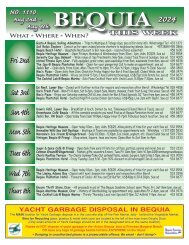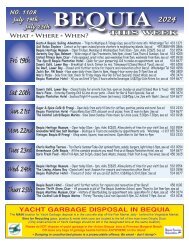Caribbean Compass Yachting Magazine - October 2021
Welcome to Caribbean Compass, the most widely-read boating publication in the Caribbean! THE MOST NEWS YOU CAN USE - feature articles on cruising destinations, regattas, environment, events...
Welcome to Caribbean Compass, the most widely-read boating publication in the Caribbean! THE MOST NEWS YOU CAN USE - feature articles on cruising destinations, regattas, environment, events...
Create successful ePaper yourself
Turn your PDF publications into a flip-book with our unique Google optimized e-Paper software.
Need Crew? Want to Crew?<br />
SailOPO.com<br />
Experienced Crew Available<br />
for short deliveries or<br />
long offshore passages.<br />
Crew requests are free.<br />
For 25 Years,<br />
US Leading Crew Network.<br />
Offshore Passage Opportunities<br />
SUPPORTSTORM<br />
<strong>October</strong>, Not All Over!<br />
by Don Street<br />
There is an old <strong>Caribbean</strong> rhyme regarding hurricanes:<br />
June, too soon<br />
July, stand by<br />
September, remember<br />
<strong>October</strong>, all over<br />
But the last line is no longer true.<br />
Sailors in the <strong>Caribbean</strong> complained bitterly in the late 1990s when insurance companies changed their closing<br />
date of hurricane season from <strong>October</strong> 30th to November 30th. The figures that follow show that the change is<br />
completely justifiable. There were more November and December hurricanes in the last ten years than there had<br />
been in the previous 50.<br />
In 1980 I obtained a book from the US National Oceanographic and Atmospheric Administration (NOAA) that<br />
showed the track charts of every hurricane from 1879 to around the mid-1970s. I then regularly obtained loosepage<br />
updates until 1988 when a new book came out that tracked all hurricanes from 1851 until then. I have since<br />
updated with loose pages right up through 2020.<br />
OCTOBER <strong>2021</strong> CARIBBEAN COMPASS PAGE 18<br />
SKN MARINE SURVEYING<br />
& CONSULTANCY<br />
GRENADA (SAMS, MECAL and ABYC)<br />
PATRICK O'LOUGHLIN<br />
Master Mariner, MSc<br />
1-473-422-2052<br />
CINDY MODESTE<br />
BSc, Naval Piloting<br />
1-473-422-5050<br />
SHELVIN THOMAS<br />
BSc. Nautical Science/<br />
Maritime Operations 1-473-407-0300<br />
CLARKES COURT BAY<br />
Woodlands<br />
St. George’s<br />
sknmarinesurveying@gmail.com<br />
www.sknmarinesurveying.com<br />
McINTYRE BROS. LTD.<br />
True Blue, St George’s Grenada<br />
Call 1 (473) 444 3944 macford@spiceisle.com<br />
We service what we sell!<br />
2 & 4-Stroke Engines Genuine Parts & Service<br />
Yamaha Certified Technicians<br />
Duty free deliveries & reliable service for Yachts<br />
Honda, Mazda and Ford Dealership<br />
Vehicle Sales & Service<br />
Book your Car rentals & Island Tours with us<br />
Discover Grenada with<br />
<strong>Caribbean</strong> Horizons Tours & Services<br />
info@caribbeanhorizons.com<br />
www.caribbeanhorizons.com<br />
GRENADA<br />
In mid-November 1999 ‘Wrong Way’ Hurricane Lenny ran from west to east.<br />
I have just done another review, as mentioned in last month’s Readers’ Forum, and have come up come up with<br />
some interesting figures on November and December hurricanes from 1950 to 2020.<br />
In the months of November from 1950 to 1980 there were eight hurricanes and four tropical storms, and the<br />
period from 1980 to 1989 saw four November hurricanes in nine years. Ten November hurricanes and nine tropical<br />
storms occurred in the 30 years from 1990 to 2020.<br />
However, with few exceptions, these November hurricanes had little or no effect on the islands of the Eastern<br />
<strong>Caribbean</strong>. The November hurricanes were either in the Western <strong>Caribbean</strong> or Gulf of Mexico, or out in the Atlantic.<br />
One notable exception was Hurricane Klaus. In early November 1984 Klaus formed south of Puerto Rico, headed<br />
northeast hitting the US and British Virgin Islands, and continued eastward passing north of St. Martin.<br />
Another remarkable exception was 1999’s famous “Wrong Way Lenny.” Hurricane Lenny was the fourth strongest<br />
November hurricane on record, behind the 1932 Cuba hurricane and 2020’s Hurricanes Iota and Eta. Lenny<br />
formed on November 13th in the western <strong>Caribbean</strong> and maintained a west-to-east track for its entire duration. It<br />
attained hurricane status south of Jamaica on November 15th and passed south of Hispaniola and Puerto Rico<br />
over the next few days. Lenny rapidly intensified over the northeastern <strong>Caribbean</strong> on November 17th, attaining<br />
peak winds of 134 knots about 21 miles south of St. Croix. It gradually weakened while moving through the<br />
Leeward Islands, eventually dissipating on November 23rd over the open Atlantic. Lenny’s storm surges affected<br />
the entire Eastern <strong>Caribbean</strong> chain.<br />
December storms can be even more surprising.<br />
Hurricane Alice formed on December 30th 1954 west of Grenada, headed northwest, took a right-angle turn<br />
passing over St. Kitts & Nevis, and then carried on out to sea. There was a December tropical storm in 1953, giving<br />
one December hurricane and one December tropical storm between 1950 and 2000. Then there were two December<br />
tropical storms in 2003, two in 2005, one in 2007 and one in 2013 — six in ten years.<br />
Going through the yearly track charts it is obvious that in the months of September and <strong>October</strong>, the northern<br />
Lesser Antilles are hit by hurricanes to the point that area from Anguilla to Puerto Rico is referred to as “Hurricane<br />
Alley.” But it’s also apparent that the next couple of months aren’t risk free.<br />
The US National Hurricane Center (NHC) has stated that <strong>2021</strong> will be an active hurricane season, so stay alert.<br />
Regularly check www.nhc.noaa/gov for information on systems that may form tropical storms or hurricanes, and<br />
note their positions, course and speed of advance.<br />
The vast majority of hurricanes that affect the islands of Eastern <strong>Caribbean</strong> start as low-pressure areas of rain<br />
southeast of the Cape Verde Islands. These move westwards into the Atlantic and sometimes pick up a circular<br />
motion. If and when one does, the NHC notes it as a tropical depression and gives its position, speed of advance,<br />
and direction. The depression sometimes forms into a tropical storm and then sometimes into a hurricane. These<br />
systems, as long as they are below 19°N, progress westwards, rarely changing course more than five degrees in 24<br />
hours. With very few exceptions the alteration of course is to the north. Very seldom has a course alteration lasted<br />
more than 48 hours before the system again turns west. Only twice since 1851 has a jog to the south lasted more<br />
than 48 hours, and those two cases lasted 72 hours then turned west again.<br />
Most tropical storms or hurricanes when they arrive at the island chain are relatively small in diameter although<br />
they may be very intense. Once a hurricane passes through the islands it can do anything, even make a right angle<br />
turn to the north, which has happened twice since 1851. Once in the <strong>Caribbean</strong>, alterations of course are to the<br />
north, never to the south. And after a hurricane passes north of 19°N it can go anywhere. If it continues on to the<br />
warm water of the Bahamas it usually builds up a big head of steam and becomes a major hurricane, causing<br />
havoc in the Bahamas and in the States.<br />
It may be <strong>October</strong>, but it’s not time to let your guard down yet.<br />
For more information on hurricanes visit Don’s website at www.street-iolare.com

















